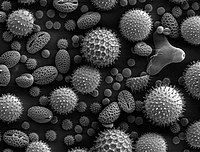
Photo from wikipedia
Objective This study aimed to investigate the gut microbiome profile in different inflammatory phenotypes of treatment-naive newly diagnosed asthmatic adults, to gain insight on the associations between intestinal microbiota and… Click to show full abstract
Objective This study aimed to investigate the gut microbiome profile in different inflammatory phenotypes of treatment-naive newly diagnosed asthmatic adults, to gain insight on the associations between intestinal microbiota and phenotypic features that characterize asthma heterogeneity to develop new treatments for asthma. Methods Fresh stool samples were obtained from 20 healthy subjects and 47 newly diagnosed asthmatic patients prior to any interventions. The asthmatics were divided into allergic and non-allergic cohorts. Intestinal microbiota was analyzed by 16S rRNA next-generation sequencing. Demographic and clinical parameters were collected. Alpha and beta diversity analysis were calculated to detect differences within sample phylotype richness and evenness between controls and asthmatic patients. Statistically significant differences between samples were analyzed for all used metrics, and features of gut bacterial community structure were evaluated in relation to extensive clinical characteristics of asthmatic patients. Results Gut microbial compositions were significantly different between asthmatic and healthy groups. Alpha-diversity of the gut microbiome was significantly lower in asthmatics than in controls. The microbiome between allergic and non-allergic asthmatic patients were also different, and 28 differential species were identified. PPAR signaling pathway, carotenoid biosynthesis, and flavonoid biosynthesis were significantly positively correlated with allergy-associated clinical index, including FENO value, blood eosinophil counts, and serum IgE and IL-4 levels. A combination of Ruminococcus bromii, Brevundimonas vesicularis, and Clostridium disporicum showed an AUC of 0.743 in the specific allergic/non-allergic cohort. When integrating C. disporicum, flavone, flavonol biosynthesis, and serum IL-4 values, the AUC achieved 0.929 to classify asthmatics. At the same time, C. colinum and its associated functional pathway exhibited an AUC of 0.78 to distinguish allergic asthmatics from those without allergies. Conclusion We demonstrated a distinct taxonomic composition of gut microbiota in different asthmatic phenotypes, highlighting their significant relationships. Our study may support considerations of intestinal microbial signatures in delineating asthma phenotypes.
Journal Title: Journal of Asthma and Allergy
Year Published: 2021
Link to full text (if available)
Share on Social Media: Sign Up to like & get
recommendations!